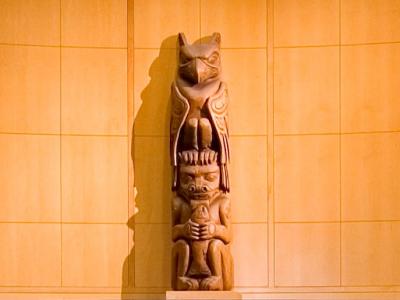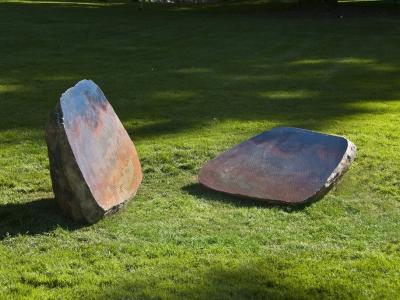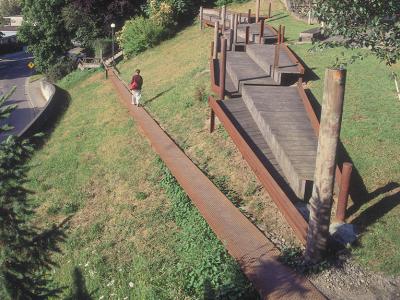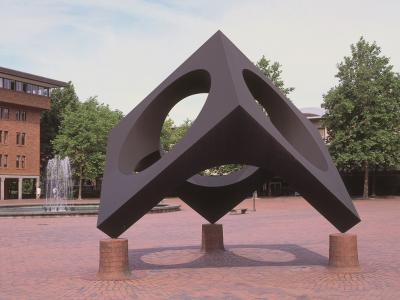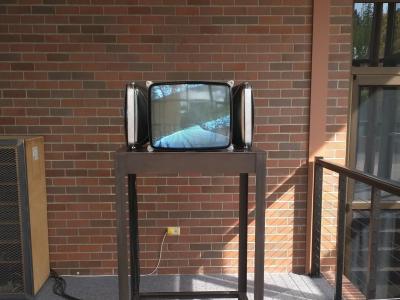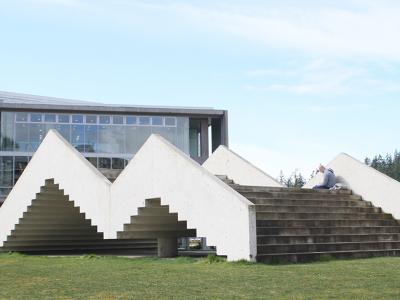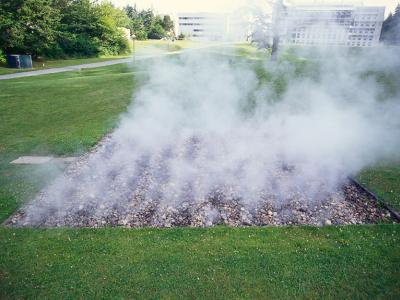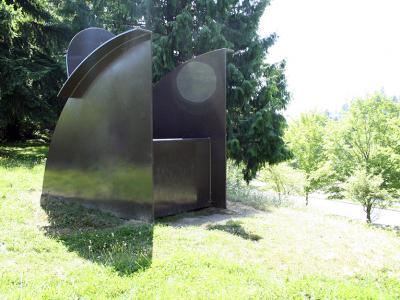Nancy Holt, Stone Enclosure: Rock Rings, 1977-78
Audio Description
Audio Transcript
Nancy Holt, 1977-78.
Brown mountain stone. 10'h. with outer ring 40' d. and inner ring 20' d.
Photo credit: Matthew Anderson. © Holt/Smithson Foundation / VAGA at Artists Rights Society (ARS), NY
Funding from the Virginia Wright Fund, the National Endowment for the Arts, Washington State Arts Commission, Western Washington University Art Fund and the artist's contributions. © Holt/Smithson Foundation / VAGA at Artists Rights Society (ARS), NY
Description
Noguchi said "he wanted to tie sculpture to the aware ness of outer space as an extension of its significance, much as one finds in early observatories. Interestingly, Nancy Holt interprets this desire-wanting to bring the sky down to the earth-in different sculptural terms that tie together cyclical patterns of earth, man, and sky. Whereas Noguchi's sculpture is thrust into the air, Holt's Stone Enclosure: Rock Rings (1977-78) is solidly on the earth and made of rock from our geological past. Holt found the Brown Mountain Stone, the 230-million year-old schist rocks, near Harrison Hot Springs, B.C. The multi-hued rocks were quarried from the side of Red Mountain (Lillooet Mountain Range) where they lie in small outcroppings or loose on the ground. At Western, Holt worked with Al Poynter, a stonemason from Ferndale who restrained himself from applying mortar as he normally would, which would have filled the crevices of the rock's natural, irregular surfaces.
Full text
In the majority of her works Holt also works with astronomers who can help her with the movements of the stars and revolutions of the earth, sun, and moon; for example, the extreme solstice position of the sun, constancy of the moon, and constitution of true north. At Western, Williard Brown helped her find the North Star Polaris with which to align the arches within the heavy walls of Rock Rings. However, Holt knew that just as Stonehenge does not work accurately anymore, she cannot be strictly dependent on Polaris being the North Star. Therefore, she is not interested in the literal readings of astronomy but rather its metaphoric nature and what it can imply for her structure.
The shape of the circle is present not only in Stonehenge, but also in the past amphitheaters of the Roman Empire, the ring forts of early Christian Ireland, and the medicine wheels of the Plains Native Americans. After Holt built Rock Rings, she was not surprised to find that centuries ago the Native Americans of Chaco Canyon (New Mexico) had repeatedly aligned some of their domestic buildings with the North Star. The circles in Holt's own work appear early as "locators." These were actual tubes that extended a person's eyes; light in the pipes reflected as if a mirror and also brought back physical images. In Rock Rings this zone of vision has been enlarged to become an architectural type of space. The functional windows pointing northeast, south west, east, west, southeast and northwest allow the viewer to be a part of the landscape. The openings make the spectator aware of the real time in his circling paces. Both circumambulation inside the two rings and alternating sights outside place the spectator into a cycle of time larger than himself.
Just as the mason Al Poynter stated that he could return someday and say he was " . . . inside those walls, somewhere," Holt started only with her own interior reality and built a quiet chamber in the south fields away about the order of the universe. As she has stated, "even when we think in celestial terms, there is still indefiniteness."
© Sarah Clark-Langager
Nancy Holt, Between Heaven and Earth
From January 13 through May 7, 2022, the Western Gallery presents "Nancy Holt, Between Heaven and Earth." The exhibition, curated by Professor of Art History Barbara Miller, follows the career path that led Holt to Stone Enclosure: Rock Rings. Aligning itself with her deep-seated desire to work across professional fields, the trans-disciplinary exhibition addresses not just the complexities of her artwork but her interests in sciences, from geology, biology, ecology, surveying technology to astronomy.





